The King Cobra is the world’s longest venomous snake, known for its intelligence, distinctive neck patterns, and powerful venom.
Kingdom: Animalia
Class: Reptilia
Order: Squamata
Family: Elapidae
Genus: Ophiophagus
Species: Ophiophagus hannah
The King Cobra is the world’s longest venomous snake. It lives in parts of Asia, from India to the Philippines. The King Cobra is known for its hood and deadly bite.
The king cobra habitat includes dense forests, bamboo thickets, and mangrove swamps. They are cold-blooded animals that prefer warm places near streams. You may wonder, what do king cobras eat? The answer is mostly snakes. They also eat lizards, rodents, and sometimes bird eggs. So, what does a king cobra eat in the wild? It often hunts pythons and Asian rat snakes. The king cobra diet helps control snake and rodent numbers. Many people also ask, how long do king cobras live? In the wild, they can live up to 20 years. This snake is dangerous but plays an important role in nature.
What is King Cobra?
The King Cobra (Ophiophagus hannah) is the world’s longest venomous snake, reaching up to 18 feet. Native to forests and wetlands in South and Southeast Asia, it’s known for its hood display and potent neurotoxic venom. Despite its fearsome reputation, the King Cobra usually avoids humans unless threatened.
This snake primarily feeds on other snakes, including venomous species. Its name “Ophiophagus” means “snake-eater.” The King Cobra plays a vital role in balancing ecosystems by controlling snake populations. Recognized for intelligence and unique nesting behavior, females guard their eggs until hatching—a rare trait among snakes. It’s currently listed as vulnerable due to habitat loss.
Size and Weight:
The King Cobra can grow up to 18 feet, making it the longest venomous snake in the world. It usually weighs between 13 to 20 pounds. Male King Cobra snakes are often longer and heavier than females.
An average adult King Cobra measures 10 to 13 feet in length. Some exceptional ones reach 18 feet. Weight can vary, but most are around 15 pounds. The King Cobra has a slender body but looks powerful when it raises its hood.
Appearance:
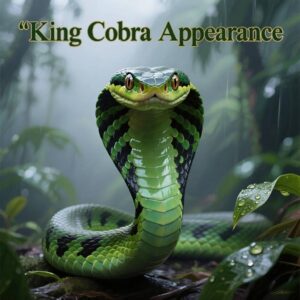
The King Cobra has smooth, olive-green, brown, or black skin with pale yellow bands. Its hood shows clear neck patterns when spread. The King Cobra can grow over 18 feet, longer than most humans. Its long, sharp fangs deliver venom quickly, making it a powerful predator.
Their eyes are medium-sized with round pupils, giving them good eyesight. The King Cobra has a slender yet muscular body, built for speed and agility. Its fangs measure about 0.5 inches long, enough to inject dangerous venom. Taller than most people when raised, the King Cobra is both elegant and intimidating in the wild.
Read More: Peregrine falcon: The world’s fastest bird
Diet:
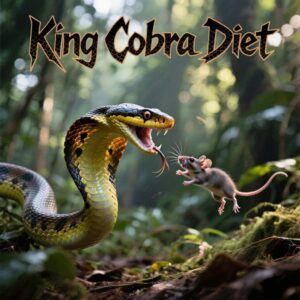
The king cobra diet is unique among snakes. It mostly eats other snakes, including pythons, Asian rat snakes, and even Indian cobras. Sometimes, it will eat lizards and small mammals. This snake hunts using its strong eyesight and sense of smell to find prey in dense forests or near streams.
So, what do king cobras eat in the wild? They often hunt during the day and strike quickly with their venomous fangs. The venom kills prey fast, making it easier to swallow whole. Eating other snakes helps control reptile numbers in their habitat. This predator plays an important role in nature.
Habitat:
The King Cobra lives in many parts of Asia, including India, China, and Indonesia. It prefers warm, humid places. You can find it in dense forests, open woodlands, bamboo thickets, and mangrove swamps. It often stays near streams and ponds where prey and water are easy to find.
King Cobras also live in agricultural areas where rodents and other snakes are common. Their *king cobra habitat* changes with food availability. They can adapt to different environments, from thick jungle to farmlands. However, habitat loss is a big threat. Cutting forests and draining wetlands make survival harder for this vulnerable species.
Geography:
The King Cobra lives across South and Southeast Asia. Its range covers India, Southern China, the Malay Peninsula, Indonesia, and the Philippines. It thrives in diverse habitats like dense forests, open woodlands, bamboo thickets, and mangrove swamps, often near streams where prey is abundant.
Breeding:
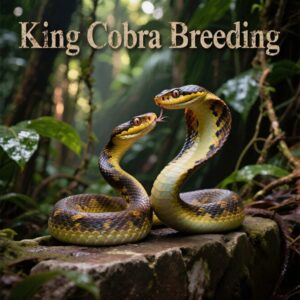
King cobras are unique among snakes because they build nests for their eggs. Breeding usually happens between January and April. A female lays 20 to 40 eggs in a mound of leaves. She guards them closely, making sure predators stay away.
The eggs take about 60 to 90 days to hatch. Baby cobras are born fully venomous and ready to hunt. The mother leaves soon after they hatch to avoid harming them. This careful brood care makes the king cobra one of the most attentive snake parents in the reptile world.
Social Structure:
The King Cobra is usually a solitary reptile. It prefers to hunt and move alone, except during breeding season. Males and females come together only to mate. This snake doesn’t live in groups like some animals. It defends its territory fiercely against other snakes and predators.
During mating season, the male may engage in ritual combat with rivals. These battles are for dominance, not to kill. Once a pair forms, they may stay together briefly. Unlike most snakes, the female builds a nest. She guards it carefully until the eggs hatch, showing rare brood care in reptiles.
This social behavior is unique among snakes. The female protects the nest by raising her hood and hissing loudly at threats. The male may stay nearby to help defend. After hatching, the young snakes are left to survive on their own in the wild.
King cobras are shy but will attack if threatened. They can lift their bodies high and strike with deadly accuracy. Their venom targets the nervous system, which can kill a person quickly. On average, they cause dozens of deaths in Asia each year, though exact numbers vary by region and reporting accuracy.
Most human encounters happen when people enter their habitat during farming or forest work. Habitat loss increases these encounters. Education, snake awareness, and proper safety can prevent many bites. Despite their danger, king cobras help control other venomous snake populations, making them important to the ecosystem.
Lifespan:
King cobras can live up to 20 years in the wild under good conditions.
Threats:
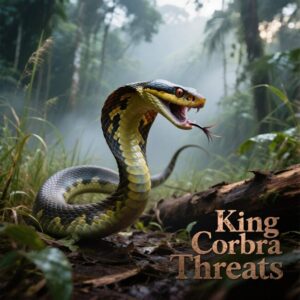
King cobras face habitat loss from deforestation and farming. They’re also killed out of fear, making them a vulnerable species in need of protection.
Conservation Status:
The King Cobra is a vulnerable species on the IUCN Red List, facing threats from habitat loss and hunting.
Conservation Efforts:
The King Cobra is a vulnerable species on the IUCN Red List. Many live in protected areas. Killing one is illegal in countries like India. It is protected under the Wildlife Protection Act of 1972.
Anyone caught killing a King Cobra in India can face jail time for up to seven years, along with heavy fines. Conservation programs focus on saving their habitats, reducing human conflict, and raising awareness in local communities.
FAQ’S
What is the largest venomous snake in the world?
The King Cobra is the largest venomous snake, growing up to 18 feet. Its size and strong venom make it one of nature’s most respected predators.
Where can this snake be found?
It lives in forests, grasslands, and swamps across South and Southeast Asia. Countries include India, China, Indonesia, and the Philippines.
How dangerous is it to humans?
Its venom attacks the nervous system, which can stop breathing. Quick medical help is needed to survive a bite from this powerful reptile.
What do they usually eat?
They hunt mostly snakes, including pythons and rat snakes. They may also eat lizards, rodents, and bird eggs if other food is not available.
How long do they live?
In the wild, they can live up to 20 years. In captivity, with proper care, they may survive a little longer.
Conclusion
The King Cobra is more than just a deadly snake. It is an important part of nature. This reptile keeps the balance by eating other snakes and controlling pests. The king cobra habitat includes forests, swamps, and bamboo thickets in Asia. Many people ask, what do king cobras eat? They feed mainly on snakes, but also on lizards, rodents, and eggs. Understanding the king cobra diet helps us see their role in the ecosystem.
Sadly, these snakes face threats from habitat loss and hunting. You may wonder, how long do king cobras live? In the wild, they can reach up to 20 years. Protecting them is vital. Laws in many countries forbid killing them. Awareness programs teach people to respect and protect them. If we care for their environment, these snakes can continue to thrive for years to come. They are not just dangerous—they are necessary.

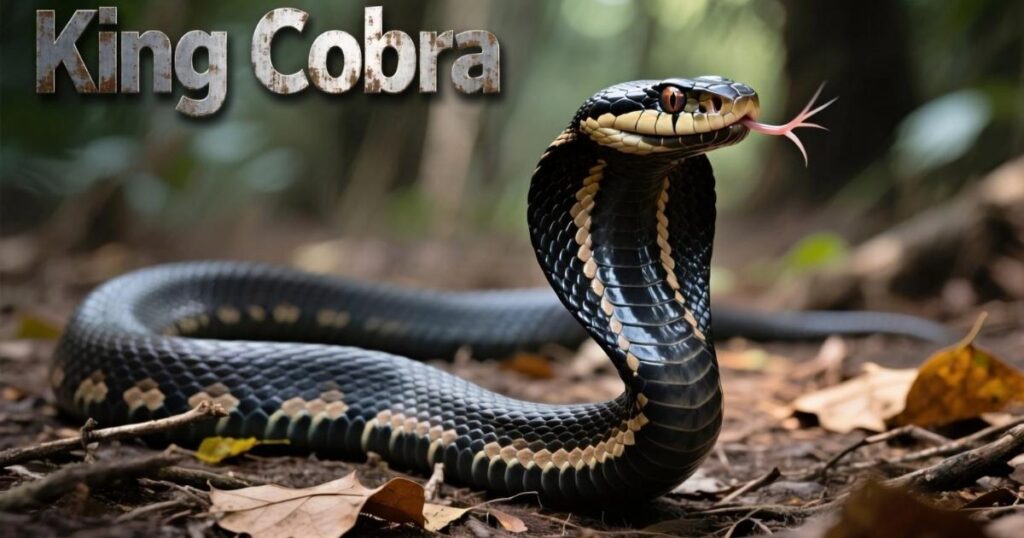
1 thought on “King Cobra Fact Sheet”